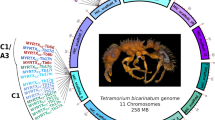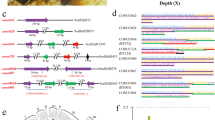Abstract
The evolvability of venom components (in particular, the gene-encoded peptide toxins) in venomous species serves as an adaptive strategy allowing them to target new prey types or respond to changes in the prey field. The structure, organization, and expression of the venom peptide genes may provide insights into the molecular mechanisms that drive the evolution of such genes. Conus is a particularly interesting group given the high chemical diversity of their venom peptides, and the rapid evolution of the conopeptide-encoding genes. Conus genomes, however, are large and characterized by a high proportion of repetitive sequences. As a result, the structure and organization of conopeptide genes have remained poorly known. In this study, a survey of the genome of Conus tribblei was undertaken to address this gap. A partial assembly of C. tribblei genome was generated; the assembly, though consisting of a large number of fragments, accounted for 2160.5 Mb of sequence. A large number of repetitive genomic elements consisting of 642.6 Mb of retrotransposable elements, simple repeats, and novel interspersed repeats were observed. We characterized the structural organization and distribution of conotoxin genes in the genome. A significant number of conopeptide genes (estimated to be between 148 and 193) belonging to different superfamilies with complete or nearly complete exon regions were observed, ~60 % of which were expressed. The unexpressed conopeptide genes represent hidden but significant conotoxin diversity. The conotoxin genes also differed in the frequency and length of the introns. The interruption of exons by long introns in the conopeptide genes and the presence of repeats in the introns may indicate the importance of introns in facilitating recombination, evolution and diversification of conotoxins. These findings advance our understanding of the structural framework that promotes the gene-level molecular evolution of venom peptides.


Similar content being viewed by others
References
Agarwal AK, Giacchetti G, Lavery G, Nikkila H, Palermo M et al (2000) CA-repeat polymorphism in intron 1 of HSD11B2: effects on gene expression and salt sensitivity. Hypertension 36(2):187–194
Ahmed M, Liang P (2012) Transposable elements are a significant contributor to tandem repeats in the human genome. Comp Funct Genom ID 947089. doi:10.1155/2012/947089
Altschul SF, Gish W, Miller W, Myers EW, Lipman DJ (1990) Basic local alignment search tool. J Mol Biol 215:403–410
Barghi N, Concepcion GP, Olivera BM, Lluisma AO (2015a) High conopeptide diversity in Conus tribblei revealed through analysis of venom duct transcriptome using two high-throughput sequencing platforms. Mar Biotechnol 17(1):81–98
Barghi N, Concepcion GP, Olivera BM, Lluisma AO (2015b) Comparison of the venom peptides and their expression in closely related Conus species: insights into adaptive post-speciation evolution of Conus exogenomes. Genome Biol Evol 7(6):1797–1814
Burset A, Seledtsov IA, Solovyev VV (2000) Analysis of canonical and non-canonical splice sites in mammalian genomes. Nucleic Acids Res 28(21):4364–4375
Cao Z, Yu Y, Wu Y, Hao P, Di Z et al (2013) The genome of Mesobuthus martensii reveals a unique adaptation model of arthropods. Nat Commun 4:2602
Casewell NR, Wüster W, Vonk FJ, Harrison RA, Fry BG (2013) Complex cocktails: the evolutionary novelty of venoms. Trend Ecol Evol 28(4):219–229
Chang D, Duda TF (2012) Extensive and continuous duplication facilitates rapid evolution and diversification of gene families. Mol Biol Evol 29:2019–2029
Chang D, Duda TF (2014) Application of community phylogenetic approaches to understand gene expression: differential exploration of venom gene space in predatory marine gastropods. BMC Evol Biol 14:123
Conticello SG, Gilad Y, Avidan N, Ben-Asher E, Levy Z, Fainzilber M (2001) Mechanisms for evolving hypervariability: the case of conopeptides. Mol Biol Evol 18:120–131
Deutsch M, Long M (1999) Intron-exon structures of eukaryotic model organisms. Nucleic Acids Res 27(15):3219–3228
Duda TF (2008) Differentiation of venoms of predatory marine gastropods: divergence of orthologous toxin genes of closely related Conus species with different dietary specializations. J Mol Evol 67:315–321
Duda TF, Palumbi SR (1999) Molecular genetics of ecological diversification: duplication and rapid evolution of toxin genes of the venomous gastropod Conus. Proc Natl Acad Sci USA 96:6820–6823
Duda TF, Palumbi SR (2000) Evolutionary diversification of multigene families: allelic selection of toxins in predatory cone snails. Mol Biol Evol 17:1286–1293
Dutertre S, Jin A, Kaas Q, Jones A, Alewood PF, Lewis RJ (2013) Deep venomics reveals the mechanism for expanded peptide diversity in cone snail venom. Mol Cell Proteom 12:312–329
Dutertre S, Jin A, Vetter I, Hamilton B, Sunagar K et al (2014) Evolution of separate predation- and defence-evoked venoms in carnivorous cone snails. Nat Commun 5:3521
Elliger CA, Richmond TA, Lenaric ZN, Pierce NT, Sweedler JV, Gilly WF (2011) Diversity of conotoxin types from Conus californicus reflects a diversity of prey types and a novel evolutionary history. Toxicon 57:311–322
Espiritu DJ, Watkins M, Dia-Monje V, Cartier GE, Cruz LJ, Olivera BM (2001) Venomous cone snails: molecular phylogeny and the generation of toxin diversity. Toxicon 39:1899–1916
Gebhardt F, Zänker KS, Brandt B (1999) Modulation of epidermal growth factor receptor gene transcription by a polymorphic dinucleotide repeat in intron 1. J Biol Chem 274(19):13176–13180
Gilly WF, Richmond TA, Duda TF, Elliger C, Lebaric Z, Schulz J, Bingham JP, Sweedler JV (2011) A diverse family of novel peptide toxins from an unusual cone snail, Conus californicus. J Exp Biol 214:147–161
Hinegardner R (1974) Cellular DNA content of the Mollusca. Comp Biochem Physiol 47A:447–460
Hong X, Scofield DG, Lynch M (2006) Intron size, abundance, and distribution within untranslated regions of genes. Mol Biol Evol 23(12):2392–2404
Hu H, Bandyopadhyay PK, Olivera BM, Yandell M (2011) Characterization of the Conus bullatus genome and its venom-duct transcriptome. BMC Genom 12:60
Jin A, Dutertre S, Kaas Q, Lavergne V, Kubala P, Lewis RJ, Alewood PF (2013) Transcriptomic messiness in the venom duct of Conus miles contributes to conotoxin diversity. Mol Cell Proteom 12(12):3824–3833
Jurka J, Kapitonov VV, Pavlicek A, Klonowski P, Kohany O, Walichiewicz J (2005) Repbase update, a database of eukaryotic repetitive elements. Cytogenet Genome Res 110:462–467
Kaas Q, Yu R, Jin A, Dutertre S, Craik DJ (2012) ConoServer: updated content, knowledge, and discovery tools in the conopeptide database. Nucleic Acids Res 40:D325–D330
Kidwell MG, Lisch DR (2001) Perspective: transposable elements, parasitic DNA, and genome evolution. Evolution 55(1):1–24
Lavergne V, Dutertre S, Jin A, Lewis RJ, Taft RJ, Alewood PF (2013) Systematic interrogation of the Conus marmoreus venom duct transcriptome with ConoSorter reveals 158 novel conotoxins and 13 new gene superfamilies. BMC Genom 14:708
Luo R, Liu B, Xie Y, Li Z, Huang W et al (2012) SOAPdenovo2: an empirically improved memory-efficient short-read de Novo assembler. GigaScience 1(18):1–6
Majewski J, Ott J (2002) Distribution and characterization of regulatory elements in the human genome. Genome Res 12:1827–1836
Nei M, Rooney AP (2005) Concerted and Birth-and-death evolution of multigene families. Annu Rev Genet 39:121–152
Olivera BM (2006) Conus peptides: biodiversity-based discovery and exogenomics. J Biol Chem 281:31173–31177
Olivera BM, Teichert RW (2007) Diversity of the neurotoxin Conus peptides, a model for concerted pharmacological discovery. Mol Interv 7:251–260
Olivera BM, Walker C, Cartier GE, Hooper D, Santos AD, Schoenfeld R, Shetty R, Watkins M, Bandyopadhyay P, Hillyard DR (1999) Speciation of cone snails and interspecific hyperdivergence of their venom peptides. Ann N Y Acad Sci 870:223–237
Pearson WR, Wood T, Zhang Z, Miller W (1997) Comparison of DNA sequences with protein sequences. Genomics 46:24–36
Puillandre N, Watkins M, Olivera BM (2010) Evolution of Conus peptide genes: duplication and positive selection in the A-superfamily. J Mol Evol 70:190–202
Puillandre N, Bouchet P, Duda TF, Kauferstein S, Kohn AJ, Olivera BM, Watkins M, Meyer C (2014) Molecular phylogeny and evolution of the cone snails (Gastropoda, Conoidea). Mol Phylogenet Evol 78:290–303
Rogozin IB, Carmel L, Csuros M, Koonin E (2012) Origin and evolution of spliceosomal introns. Biol Direct 7:11
Sanggaard KW, Bechsgaard JS, Fang X, Duan J, Dyrlund TF et al (2014) Spider genomes provide insight into composition and evolution of venom and silk. Nat Commun 5:3765
Senapathy P, Sharpiro MB, Harris NL (1990) Splice junctions, branch point sites and exons: sequence statistics, identification and applications to genome projects. Methods Enzymol 183:252–278
Simpson JT, Durbin R (2012) Efficient de novo assembly of large genomes using compressed data structures. Genome Res 22(3):549–556
Simpson JT, Wong K, Jackman SD, Schein JE, Jones SJM, Birol İ (2009) ABySS: a parallel assembler for short read sequence data. Genome Res 19(6):1117–1123
Slater GSC, Birney E (2005) Automated generation of heuristics for biological sequence Comparison. BMC Bioinformatic 6:31
Smit AFA, Hubley R (2008–2015) RepeatModeler Open-1.0. http://www.repeatmasker.org. Accessed 23 Sept 2015
Smit AFA, Hubley R, Green P (2013–2015) RepeatMasker Open-4.0. http://www.repeatmasker.org. Accessed 23 Sept 2015
Stockwell T, Baden-Tillson H, Favreau P, Mebs D, Ducancel F, Stöcklin R (2010) Sequencing the genome of Conus consors: preliminary results. In: Barbier J, Benoit E, Marchot P, Mattéi C, Servent D (eds) Advances and new technologies in toxinology. SFET Editions, Gif sur Yvette, France, pp 11–16. http://www.sfet.asso.fr. ISSN 1760-6004. Accessed 23 Sept 2015
Thanaraj TA, Clark F (2001) Human GC-AG alternative intron isoforms with weak donor sites show enhanced consensus at acceptor exon positions. Nucleic Acids Res 29(12):2581–2593
The UniProt Consortium (2015) UniProt: a hub for protein information. Nucleic Acids Res 43:D204–D212
Vonk FJ, Casewell NR, Henkel CV, Heimberg AM, Jansen HJ et al (2013) The king cobra genome reveals dynamic gene evolution and adaptation in the snake venom system. Proc Natl Acad Sci USA 110(51):20651–20656
WarrenWC Hillier LW, Marshall Graves JA, Birney E et al (2008) Genome analysis of the platypus reveals unique signatures of evolution. Nature 453(8):175–184
Watkins M, Hillyard DR, Olivera BM (2006) Genes expressed in a turrid venom duct: divergence and similarity to conotoxins. J Mol Evol 62(3):247–256
Wong ESW, Papenfuss AT, Whittington CM, Warren WC, Belov K (2012) A limited role for gene duplications in the evolution of platypus venom. Mol Biol Evol 29(1):167–177
Wu Y, Wang L, Zhou M, You Y, Zhu X, Qiang Y, Qin M, Luo S, Ren Z, Xu A (2013) Molecular evolution and diversity of Conus peptide toxins, as revealed by gene structure and intron sequence analyses. PlosOne 8(12):e82495
Yuan D, Han Y, Wang C, Chi C (2007) From the identification of gene organization of α conotoxins to the cloning of novel toxins. Toxicon 49:1135–1149
Acknowledgments
The specimen used in this study was obtained in conjunction with a collection trip supported in part by ICBG Grant #1U01TW008163. The data analysis was carried out using the high performance computing systems at the Philippine Genome Center-Core Facility for Bioinformatics and the High-Performance Computing Facility of the Advanced Science and Technology Institute and the Philippine e-Science Grid, Diliman, Quezon City. We are grateful to the constructive comments of anonymous reviewers.
Author information
Authors and Affiliations
Corresponding author
Ethics declarations
Conflict of interest
Neda Barghi declares that she has no conflict of interest. Gisela P. Concepcion declares that she has no conflict of interest. Baldomero M. Olivera declares that he has no conflict of interest. Arturo O. Lluisma declares that he has no conflict of interest.
Funding
This study was funded by a research grant to AOL from the Emerging Interdisciplinary Research Program of the University of the Philippines System through the Philippine Genome Center.
Ethical approval
All applicable international, national, and/or institutional guidelines for the care and use of animals were followed.
Additional information
Communicated by S. Hohmann.
This Whole Genome Shotgun project has been deposited at DDBJ/EMBL/GenBank under the accession LFLW00000000. The version described in this paper is version LFLW01000000.
Electronic supplementary material
Below is the link to the electronic supplementary material.
Rights and permissions
About this article
Cite this article
Barghi, N., Concepcion, G.P., Olivera, B.M. et al. Structural features of conopeptide genes inferred from partial sequences of the Conus tribblei genome. Mol Genet Genomics 291, 411–422 (2016). https://doi.org/10.1007/s00438-015-1119-2
Received:
Accepted:
Published:
Issue Date:
DOI: https://doi.org/10.1007/s00438-015-1119-2




